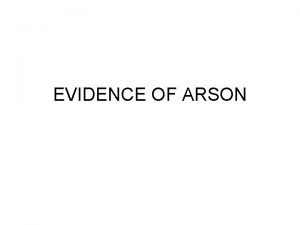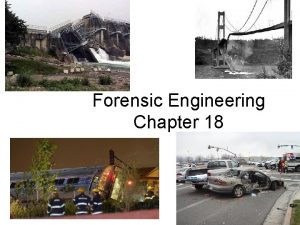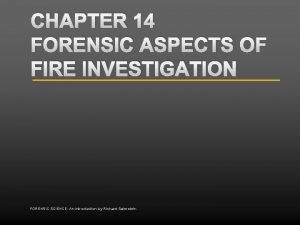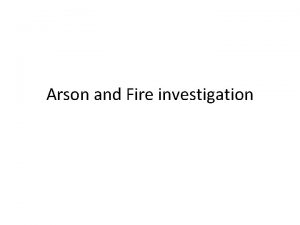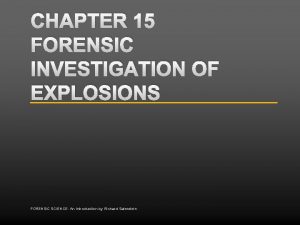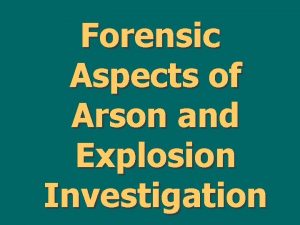Forensic Aspects of Fire Investigation Chapter 12 Forensic















- Slides: 15

Forensic Aspects of Fire Investigation Chapter 12

Forensic Investigation of Arson R Arson often presents complex and difficult circumstances to investigate due to the fact that the perpetrator has thoroughly planned the act, is not present during the act, and the destruction is so extensive. R The criminalist’s function is rather limited to detecting and identifying relevant chemical materials collected at the scene and reconstructing and identifying ignitors or detonating mechanisms. R Must establish a motive, the modus operandi (an offender’s pattern of operation), and a suspect.

The Chemistry of Fire R Chemically, fire is a type of oxidation, which is the combination of oxygen with other substances to produce new substances. R CH 4 + 2 O 2 yields CO 2 + 2 H 20 R To start fire, the minimum temperature needed to spontaneously ignite fuel, known as ignition temperature, must be reached. R The heat evolved when a substance burns is known as heat of combustion. R An additional factor, besides the liberation of energy, needed to explain fire is the rate or speed at which the oxidation reaction takes place.

The Chemistry of Fire R A fuel will achieve a reaction rate with oxygen sufficient to produce a flame only when it is in the gaseous state. R A liquid burns when the temperature is high enough to vaporize it (flash point), while a solid must be hot enough to decompose into gaseous products (pyrolysis). R Glowing combustion or smoldering is burning at the fuel-air interface, such as a cigarette. R Spontaneous combustion, which is rare, is the result of a natural heat-producing process in poorly ventilated containers or areas.

The Fire Scene R The arson investigator needs to begin examining a fire scene for signs of arson as soon as the fire has been extinguished. R Experience shows that most arsons are started with petroleum-based accelerants. R The necessity to begin an immediate investigation even takes precedence over the requirement to obtain a search warrant. R The search of the fire scene must focus on finding the fire’s origin, which may be most productive in any search for an accelerant or ignition device.

The Fire Scene R Some telltale signs of arson include evidence of separate and unconnected fires, the use of “streamers” to spread the fire from one area to another, and evidence of severe burning found on the floor as opposed to the ceiling of a structure, due to a flammable liquid. R Normally, a fire has a tendency to move in an upward direction, and thus the probable origin will most likely be the lowest point showing the most intense characteristics of burning. R Fortunately, combustible liquids are rarely entirely consumed during a fire.

Collection R At the suspect point of origin of a fire, ash and soot, along with porous materials which may contain excess accelerant, should be collected and stored in airtight containers, leaving an airspace to remove samples. R Traces of flammable liquid residues may be located with a vapor detector (sniffer). R It is important that a sampling of similar but uncontaminated control specimens be collected. R A search for ignitors such as matches, an electrical sparking device, or parts of a “Molotov cocktail” must also be conducted.

The Basics RWhen a fire occurs, oxygen combines with a fuel to produce noticeable quantities of heat and light (flames). RIf combustion is to be initiated and sustained, a fuel must be present, oxygen must be available, heat must be applied to initiate the combustion, and sufficient heat must be generated to sustain the reaction. RA fuel will achieve a reaction rate with oxygen sufficient to sustain a fire only when it is in the gaseous state.

Analysis of Flammable Residues RHeadspace Technique RThe easiest way to recover accelerant residues from fire-scene debris is to heat the airtight container in which the sample is sent to the laboratory. RWhen the container is heated, any volatile residue in the debris is driven off and trapped in the container’s enclosed airspace. RThe vapor or headspace is then removed with a syringe. RSize of syringe limits the volume of vapor

Analysis RWhen the vapor is injected into the gas chromatograph, it is separated into its components, and each peak is recorded on the chromatogram. RThe resultant chromatogram is compared to patterns produced by known petroleum products. RThe brand name of a gasoline sample cannot currently be determined by gas chromatography or any other technique.

Vapor Concentration RA charcoal-coated strip is placed within the container holding the debris that has been collected from the fire scene. RThe container is then heated to about 60 o. C for about one hour. RAt this temperature, a significant quantity of accelerant vaporizes into the container airspace. RThe charcoal absorbs the vapor. RIt will be concentrated onto the strip.

Apparatus for accelerant recovery by vapor concentration. The vapor in the enclosed container is exposed to charcoal, a chemical absorbent, where it is trapped for later analysis.

Gas Chromatography R In the laboratory, the gas chromatograph is the most sensitive and reliable instrument for detecting and characterizing flammable residues. R The vast majority of arsons are initiated by petroleum distillates such as gasoline and kerosene. R The gas chromatograph separates the hydrocarbon components and produces a chromatographic pattern characteristic of a particular petroleum product. R By comparing select gas chromatographic peaks recovered from fire-scene debris to known flammable liquids, a forensic analyst may be able to identify the accelerant used to initiate the fire.

Chromatogram of a residue sample collected at a fire scene (A) shows a pattern somewhat like that of gasoline (B). However, a definitive conclusion that the unknown contained gasoline could be obtained only after extraneous peaks were eliminated from the unknown by the use of GC/MS (C).

Figure 11– 8 (top) Gas chromatograph of vapor from a genuine gasoline sample. (bottom) Gas chromatograph of vapor from debris recovered at a fire site. Note the similarity of the known gasoline to vapor removed from the debris. Courtesy New Jersey State Police.
 Forensic science foodborne outbreak investigation answers
Forensic science foodborne outbreak investigation answers Arson evidence collection and analysis
Arson evidence collection and analysis Catching killers fire investigation
Catching killers fire investigation Pathologist and anthropologist
Pathologist and anthropologist Who is this
Who is this Reichstag fire who was the fire starter
Reichstag fire who was the fire starter Damper fire alarm
Damper fire alarm Fire hose reel signage standards
Fire hose reel signage standards A-e rwi
A-e rwi Extinguisher parts
Extinguisher parts Chapter 2 legal and ethical aspects of nursing
Chapter 2 legal and ethical aspects of nursing The seven s's of crime scene investigation
The seven s's of crime scene investigation Forensic science chapter 18 review answers
Forensic science chapter 18 review answers Forensic science chapter 17 review answers
Forensic science chapter 17 review answers Chapter 14 review forensic science
Chapter 14 review forensic science Observation definition forensics
Observation definition forensics

